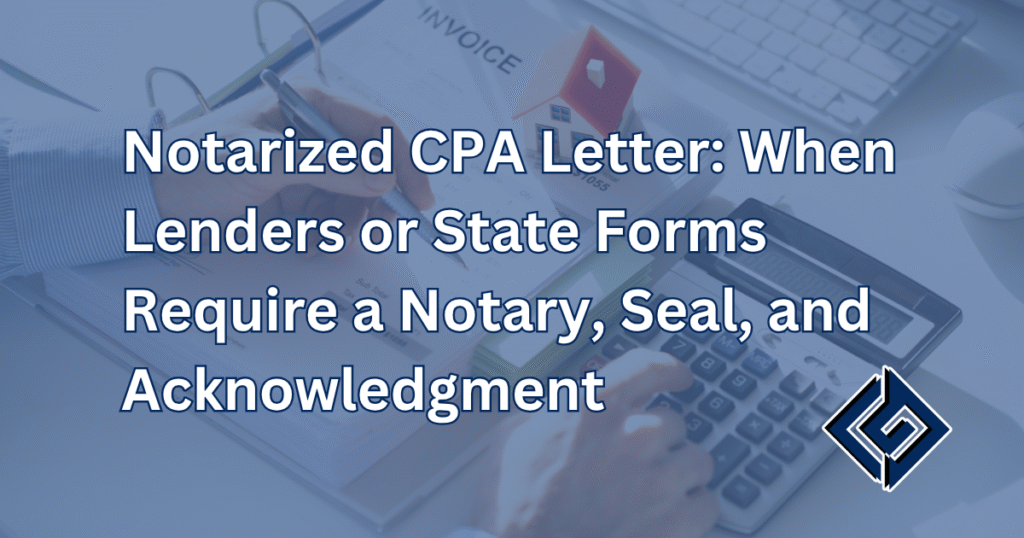A notarized CPA letter adds formality and identity checks to a standard CPA document. Lenders, agencies, and some state forms ask for a notary’s seal and acknowledgment to confirm the signature, date, and signer’s identification. This article explains when notarization is needed, how it works with a CPA comfort letter, and what to prepare so your file moves without delays.
What “Notarized” Means in Practice
A notary verifies identity, witnesses the signing, and completes a certificate.
The notary is not validating the accounting content. The notary is validating authenticity of the signature event.
Core Elements of a Notarial Act
- Identification. Government ID, credible witness, or state-approved methods.
- Acknowledgment or Jurat. You acknowledge signing (acknowledgment) or swear/affirm the content (jurat).
- Notary Certificate. Venue, date, signer’s name, notary’s name, seal, and commission expiration.
What a Notary Does Not Do
- Does not audit numbers.
- Does not offer legal conclusions about the letter.
- Does not replace lender underwriting.
When Lenders and Agencies Ask for Notarization
Requests appear in mortgage, licensing, and certain government packets.
You may also see it in asset-based lending and adoption or immigration checklists.
Common Triggers
- Mortgage conditions that say “notary acknowledgment required.”
- State or agency forms listing “affidavit,” “sworn statement,” or “acknowledgment.”
- Letters that accompany contracts, PDF forms, or funds-source confirmations.
Examples of Notarized Documents in the Wild
- Affidavits for residency or business activity.
- Power of Attorney related to closing or document pickup.
- Income confirmations that must be notarized for a state program.
Notarized CPA Letter vs. CPA Comfort Letter
Both serve underwriting. They have different purposes.
CPA Comfort Letter (Context and Procedures)
A CPA comfort letter describes what the CPA did: tie-outs to financial statements, agreement to tax filings, and any recalculated ratios. It states limits and avoids assurance. It may or may not be notarized.
Notarized CPA Letter (Identity and Formality)
A notarized CPA letter is any CPA letter that includes a notary block and seal.
Notarization confirms who signed and when. It does not change the accounting scope.
Can a Comfort Letter Be Notarized?
Yes. If the requester insists, the CPA can add a notary acknowledgment to the comfort letter format. Keep the scope language intact and compliant.
States and Remote Options: Practical Notes
Notary rules are state-specific. Legislation controls in-person vs. remote online notarization(RON).
State Mentions You’ll Commonly See
Texas, Arizona, Nevada, Iowa, Ohio, Utah, Idaho, Alaska, Virginia, Colorado.
These states have enacted various forms of RON or remote allowances. Exact procedures vary. Your notary will follow local law.
Remote Online Notarization (RON)
- In approved states, a commissioned e-notary performs identity authentication via knowledge-based checks and credential analysis.
- The signing occurs on a secure platform with eSigns and video recording.
- Output is a tamper-evident PDF with an electronic notary seal.
When RON Helps
- Signers in different cities or time zones.
- Urgent files that cannot wait for in-person scheduling.
- After-hours windows; some platforms support 24/7 availability through on-call networks (availability still depends on state law and the provider).
What the Notarized CPA Letter Typically Includes
Keep the accounting content clear. Then add the notary elements.
Accounting Content (Prepared by the CPA)
- Client name and purpose (e.g., mortgage underwriting).
- Period covered and the records referenced (tax filings, bank activity, financial statements).
- Procedures performed if this is also a CPA comfort letter.
- Scope limits (not an audit, not legal advice).
Notary Content (Completed by the Notary)
- Venue (State/County).
- Acknowledgment or jurat language.
- Date, signer, notary name/commission, and seal.
- The notary’s signature.
Attachment or Integrated Block?
Some recipients want the notary block on the same page. Others accept an attached certificate stapled to the letter. Follow the checklist.
Workflow: From Request to Delivery
A tidy process reduces last-minute issues and rework.
Step 1: Clarify the Request
- Exact wording from the lender or agency.
- Acknowledgment vs. jurat.
- In-person vs. RON allowed in your state (e.g., Virginia RON differs from Texas RON rules).
Step 2: Prepare the Letter
- Draft the CPA content; confirm verification procedures if it’s also a comfort letter.
- Convert to PDF with final formatting for clean archiving.
Step 3: Identity and Scheduling
- Bring valid ID that meets state rules for notarization.
- For RON, complete the platform’s identity authentication and system checks.
Step 4: Sign and Seal
- The CPA signs in the notary’s presence (or during the live remote session).
- The notary completes the certificate and applies the seal.
Step 5: Delivery and Storage
- Send the notarized PDF to the portal or email listed on the condition.
- Retain copies for the loan or licensing file.
Edge Cases and How to Handle Them
Multi-State Closings
When the lender operates across states (e.g., Colorado property, Arizona signer), confirm where the notarization occurs and which law governs.
Corporate Signer vs. Individual
If the CPA letter references a company, ensure the signer’s capacity (e.g., officer) is clear. Some notary blocks ask for title.
Affidavit Language
If the recipient insists on “affidavit” wording, ask whether a jurat is required. A jurat involves an oath/affirmation, which the notary administers.
Power of Attorney
If a Power of Attorney is being used, many institutions require the POA to be notarized and on file before accepting the CPA letter signed under POA authority.
Compliance and Professional Boundaries
Stay Within AICPA and State Rules
A CPA must keep the letter within professional standards.
Scope creep turns a simple letter into unintended auditing language. Avoid that.
Regulatory Compliance and Internal Controls
The lender’s compliance team uses notarization to reduce identity risk.
Your clean trail—request, draft, acknowledgment—helps their internal controls.
Insurance and Liability
Notaries and CPAs operate under licensing regimes.
The CPA manages professional liability through careful wording; the notary manages journal entries and seal controls under state legislation.
